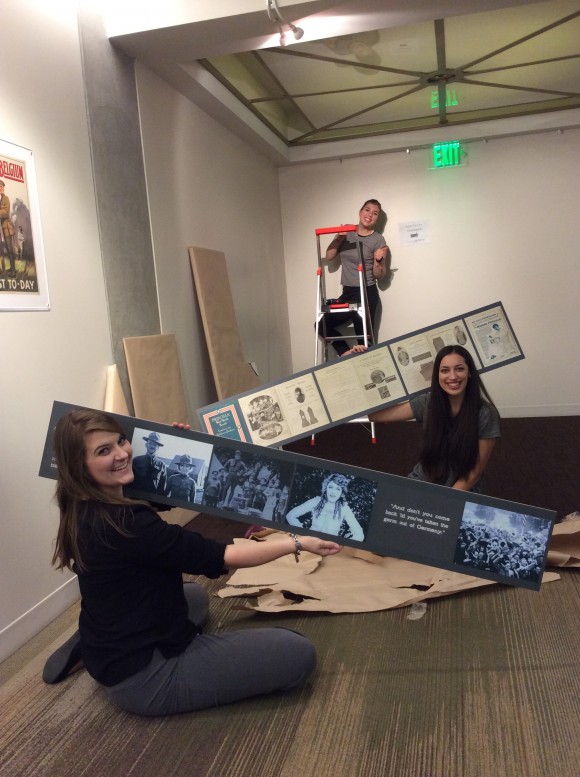Students Cross Curricula to Create WWI Exhibition
February 12, 2015
Last night marked the official opening of To Arms: The Western Front, 1914-1918, our new spring semester exhibit of WWI artifacts in the Doy and Dee Henley Galleria on the second floor of Argyros Forum.
This was a collaborative effort among various departments and groups of students at Chapman, and it’s the first time that students were given the lead in the curatorial and design process. Planning and installing the exhibition has been hard work, but a great learning experience for all involved. A handful of students saw the exhibition through to every last stage, including the final install during the month of interterm.
“I have always been interested in museum work and this gave me a glimpse into the world of curating. I had never before realized just how much planning and effort must go into an exhibit to make it successful,” remarked McKenzie Tavoda. Many of the students shared similar feelings about the amount of effort that was required to see their original visions come to fruition. Maci Reed shared that “after months of planning, writing, editing, and designing… I expected hanging some shelves and setting the artifacts on them to be straightforward. In actuality, the installation process was far more complicated and time consuming than I imagined.” In the end though, that’s part of what made the work even more fulfilling, as Bijan Kazerooni explained, “What I found the most invigorating with this project was the progress made from starting out with completely empty cases to finishing with an authentic museum exhibit.”
For some of the students, who are more accustomed to working with the contemporary and modern works of art in our Escalette Collection, this was a nice change of pace. Manon Wogahn said, “It was a strange transition to go from working with contemporary works of art to hundred-year-old objects that experienced such a gruesome and historic war. I think the most rewarding aspect of this exhibition was, for me, being able to handle these artifacts.” While Alex Allen had similar sentiments to Ms. Wogahn, she also expressed a different sort of caution with a few of the items on display. “Actually being able to handle objects that have such a storied past was exhilarating– although, to be completely honest, we did have some reservations about handling the grenade.”

Student curators and installers, Jessica Johnson, Manon Wogahn, and Alex Allen, receive their printed materials to hang in the exhibition.
Jessica Johnson, who also works with the Escalette Collection of Art, thought the historical focus of this exhibit solidified her understanding of the relationship between art and history: “The two go hand in hand for me, as art is an extension of the human condition, past, present, and future.”
In fact, the diversity of interests each student brought to the exhibition process only strengthened the final outcome. The collaboration “ensured that all the visual and historical elements merged in a way which best allowed us to communicate the story of World War One through these objects,” says Ms. Allen. Ms. Reed added, “layouts which looked good on paper or a computer screen were not always aesthetically pleasing in person. The entire process proved difficult and required a keen sense of perspective.”
This crew of thirteen student curators and four student designers ultimately managed to create an exhibition that’s informative, visually engaging, and reverent to the subject matter. As Jessica Johnson notes, “Nearly a century ago, these objects protected soldiers and helped influence the course of the war. Real people wore, touched and made these items all those years ago, and today they sit in Argyros Forum to be appreciated by all passersby.”



